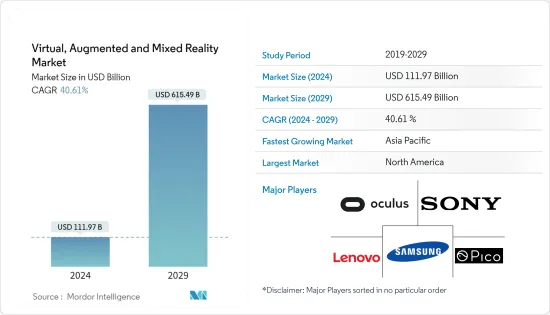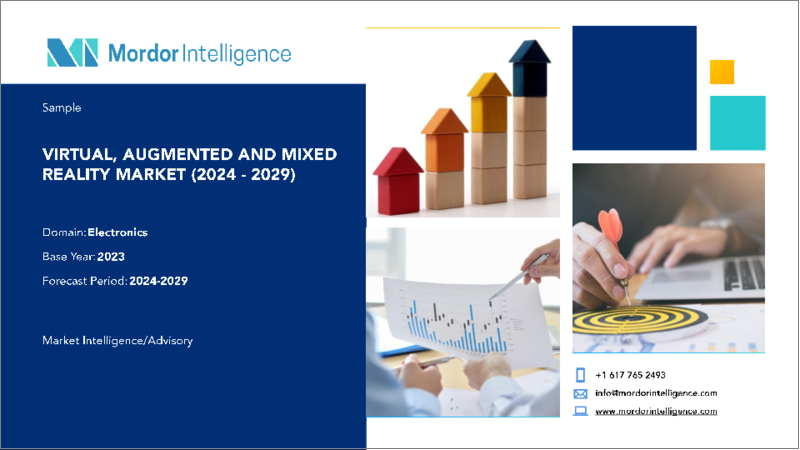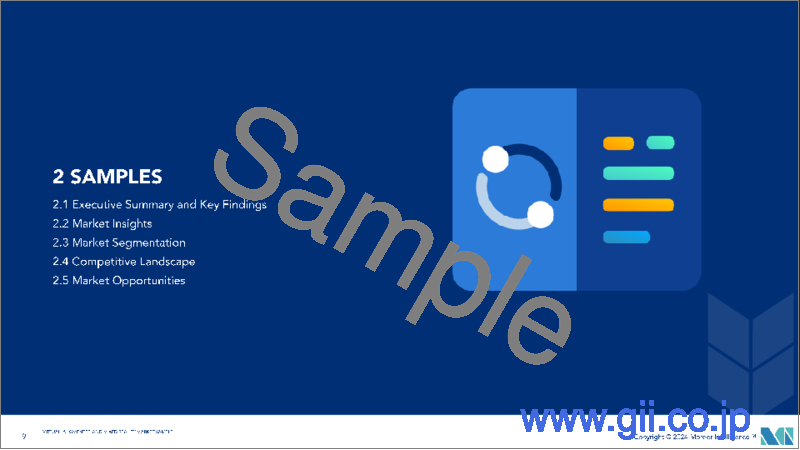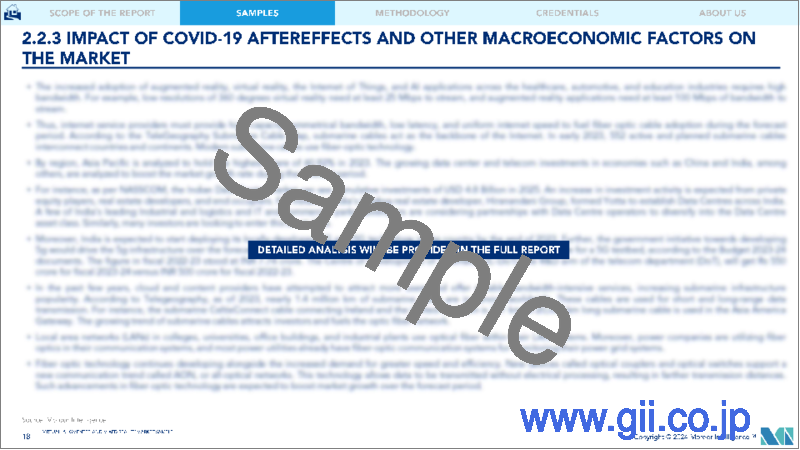|
|
市場調査レポート
商品コード
1521412
仮想・拡張・複合現実:市場シェア分析、産業動向と統計、成長予測(2024年~2029年)Virtual, Augmented, And Mixed Reality - Market Share Analysis, Industry Trends & Statistics, Growth Forecasts (2024 - 2029) |
||||||
カスタマイズ可能
適宜更新あり
|
|||||||
| 仮想・拡張・複合現実:市場シェア分析、産業動向と統計、成長予測(2024年~2029年) |
|
出版日: 2024年07月15日
発行: Mordor Intelligence
ページ情報: 英文 314 Pages
納期: 2~3営業日
|
- 全表示
- 概要
- 目次
仮想・拡大・複合現実(Virtual, Augmented And Mixed Reality)市場規模は、2024年に1,119億7,000万米ドルと推定され、2029年には6,154億9,000万米ドルに達すると予測され、予測期間中(2024~2029年)のCAGRは40.61%で成長する見込みです。

主要ハイライト
- バーチャルリアリティは、主にシミュレートされた環境を生成することを目的としたコンピュータ技術の活用です。従来のユーザーインターフェースとは対照的に、VRはユーザーがモニター画面を単に観察するのではなく、没入体験に完全に関与することを可能にします。この技術は、視覚、触覚、聴覚、嗅覚といった多感覚シミュレーションを提供することで、間違いなく世界的に様々な面で革命を起こしています。
- 対照的に、拡大現実は、コンピューターが生成した知覚情報を取り入れることによって現実世界を豊かにする魅惑的な体験です。拡大現実は、ソフトウェア、アプリ、ARメガネのようなハードウェアを利用することで、私たちの身の回りや物体にデジタルコンテンツをシームレスに取り込みます。
- 拡大現実(AR)は、この技術が商業環境で広く利用されているため、著しい成長を遂げています。Apple、Google、Facebook、Microsoft、Amazonのような著名な技術市場のリーダーによる技術革新と導入への多額の投資を考慮すると、今後数年間は重要な位置を占めると予想されます。スマートフォンの存在感の拡大とモバイルゲームにおけるARの統合の増加は、この市場の主要促進要因であり、このセグメントの主要ベンダーによるソリューションのさらなる開拓につながっています。
- 複合現実を利用することで、教師は仮想的な概念の例を提示したり、教科書を補完するためにゲーム要素を取り入れたりすることができるため、教室教育の双方向性が高まる可能性があります。その結果、この革新的なアプローチは、生徒の学習を加速させ、情報の定着を向上させる。
- 特に大学や専門学校では、教育期間中に集中力を維持することが難しいという課題に直面する学生が増えていることを認識する価値があります。また、うつ病や不安症など、さまざまな精神衛生上の問題に遭遇することもあります。
- バーチャル・リアリティーは、様々なエンドユーザー産業に顕著な影響を与える革命的技術として台頭しつつあります。この技術の受け入れは継続的に拡大しており、使用事例の大幅な拡大につながっています。また、バーチャル・リアリティ技術にはいくつかの利点があり、これまでのビジネスや営利企業の原動力を変えつつあります。
- 例えば、この技術は消費者の体験を向上させるために小売業界で利用されています。商品を購入する前に、バーチャル環境で商品を確認することができます。この技術を利用することで、さまざまなエンドユーザー業界の企業は、より多くの顧客の注目を集めるための強力なマーケティング・キャンペーンを展開することができます。また、仮想環境で手順を提供することで、リモート・メンテナンスやサポートを提供するのにも役立ちます。
- トレーニングやスキル開発は、バーチャル・リアリティ技術の需要が大幅な成長を遂げると予想される主要セグメントの1つであり、その主要理由は、この技術がプロセスに利便性をもたらすためです。さらに、従来の方法よりも安全なプロセスを実現しながら、全体的なトレーニングコストを最小限に抑えることもできます。例えば、危険な環境で作業する従業員を訓練するために、組織は従業員を実際の現場に派遣するのではなく、シミュレートされた仮想環境を使用することができます。
- AR/VR/MR市場は様々な産業で拡大しつつあるが、これらは新興の技術であり、標準化と大衆受容がまだ達成されていないため、技術的・コスト的な限界は市場に関連したままです。さらに、これらの技術は複雑であり、さらなる開発には熟練した労働力が必要です。したがって、熟練労働者が十分に確保できないことも、市場の成長を阻む大きな課題となっています。
仮想・拡張・複合現実市場の動向
VRのエンドユーザーとして急成長するゲーム
- バーチャルリアリティ(VR)は、没入感のあるダイナミックな体験を提供できることから、ゲームセグメントで広く利用されるようになりました。参入企業を仮想環境に直接送り込むことで、VRは臨場感と没入感を生み出します。バーチャルリアリティヘッドセットにより、参入企業は一人称視点でゲームを体験できます。この没入感の高さがゲーム体験を向上させ、参入企業は仮想世界やそのキャラクターとのつながりをより強く感じることができます。
- フルハイビジョン(FHD)、ウルトラハイビジョン(UHD)、4Kディスプレイなどの新技術の研究開発が、ゲームをプレイするためのテレビの採用を後押ししています。ゲーム産業におけるバーチャルリアリティの成長も、新技術への投資の増加によって刺激されています。VRゲーム産業の将来は、グラフィックス性能の継続的な向上が牽引すると予測されます。ゲーム会社は、物理的環境と空想的環境を統合する最高のVRゲームを提供するために、強力なグラフィックス・プロセッサを使用しています。グラフィックは、リアルなゲーム体験を提供する上で不可欠な役割を果たしています。バーチャルリアリティプラットフォーム上でゲームをプレイしたり歩いたりする際に、3D効果やインタラクティブなグラフィックなどの技術によって、リアルタイムの専門知識がユーザーに提供されます。
- 世界のARとVRゲーマーの急成長により、市場の視野が広がっています。人工知能、機械学習、ビッグデータ分析、AR/VRソリューションを提供するNewGenAppsによると、ARとVRゲームの世界のユーザー数は2025年までに2億1,600万人に増加するといいます。
- ビデオゲームに対する需要の増加は、ベンダーがVRヘッドセットを提供する機会を生み出します。Entertainment Retailers Associationによると、2022年に英国の消費者はビデオゲームに約46億6,000万英ポンド(59億5,000万米ドル)を費やしました。これは前年比2.3%増に相当します。2028年には、VRヘッドセットの市場規模は2,700万台を超えると予想されています。
- ゲーム業界はVRの市場ポテンシャルを認識しています。この技術がより身近で手頃なものになるにつれて、VRゲーム体験の需要が高まっています。ゲーム開発者やパブリッシャーは、VRを新たな視聴者を獲得し、混雑した市場で際立つエキサイティングで没入感のある体験を創造する機会と捉えています。
仮想・拡張・複合現実市場で北米が大きな市場シェアを占める
- 北米におけるバーチャルリアリティ(VR)の需要は、さまざまなセグメントの個人が技術に関わるようになったことが大きな要因となって急成長を遂げています。この需要の増加は、エンターテインメントやゲームから教育、医療、企業ソリューションなど、VR技術のさまざまな用途によって促進されています。
- VRの需要は、技術の進歩によってVRデバイスがより身近でユーザーフレンドリーになったことで、さらに促進されています。VRヘッドセットの手頃な価格と性能の向上は、技術愛好家から斬新で魅力的な体験を求めるカジュアルユーザーまで、北米全域での幅広い普及に貢献しています。そのため、多くの企業が市場シェアを拡大するために新製品を発売しています。
- VRがより身近で使いやすくなるにつれ、政府が革新的なアプローチを模索する上でも大きな可能性が広がっています。それゆえ米国政府は、複数のセグメントでVRを貴重なツールとして活用しています。例えば、米国食品医薬品局は2023年9月、通常はクリニックや病院でのみ提供される臨床サービスの一部を、VRによって患者の自宅やその他の非臨床環境で提供できると発表しており、来年にはこれが増加し、VRの需要が高まると考えられます。
- 複数のベンダーが市場革新に多額の投資を行っていることと、米国が世界のソフトウェア市場で圧倒的な地位を占めていることから、北米の拡大現実市場は予測期間中に大きく成長すると予想されます。
- 北米市場におけるモバイルの普及率の上昇と新しいコンソールの利用可能性が、ここ数年のゲームセグメントの著しい成長に寄与しています。米国は世界最大級のゲーム市場であり、国民に多くのゲームを提供しています。米国では、パンデミック(COVID-19)の隔離期間中にビデオゲームをプレイした時間が、以前の週と比べて45%増加したと報告されています。
- 北米における複合現実感(MR)の需要は、さまざまなセグメントの個人が技術に関わるようになったことが大きな要因となって急成長を遂げています。複数のベンダーが市場革新に多額の投資を行っていることと、米国が世界市場で圧倒的な地位を占めていることから、北米の複合現実市場は予測期間中に大きく成長すると見られています。
仮想・拡張・複合現実産業概要
仮想・拡張・複合現実市場は、Oculus VR LLC(Meta Platform Technologies)、Sony Corporation、Samsung Electronics、Lenovo Group Ltd、Pico Interactive Inc.などの主要企業が存在し、非常に断片化されています。市場の参入企業は、製品ラインナップを強化し、サステイナブル競争優位性を獲得するために、提携や買収などの戦略を採用しています。
- 2023年11月-Samsung Electronicsは2024年後半にGalaxy Z Flip6とGalaxy Z Fold6と共に次期複合現実ヘッドセットを発売する計画を発表しました。同社によると、SamsungはGoogle、Qualcommと共同で複合現実型ヘッドセットの開発に取り組んでいます。
- 2023年9月-Oculus VR LLCは、没入型技術を教える米国15大学との新たな提携プログラムを発表。各大学は、没入型技術が教育の未来をどのように前進させるかを探求するために、バーチャルリアリティ教室や演習を開催しています。
その他の特典:
- エクセル形式の市場予測(ME)シート
- 3ヶ月間のアナリストサポート
目次
第1章 イントロダクション
- 調査の前提条件と市場定義
- 調査範囲
第2章 調査手法
第3章 エグゼクティブ概要
第4章 市場洞察
- 市場概要
- 業界の魅力-ポーターのファイブフォース分析
- 供給企業の交渉力
- 買い手の交渉力
- 新規参入業者の脅威
- 代替品の脅威
- 競争企業間の敵対関係の強さ
- COVID-19の影響とその他のマクロ経済要因が市場に与える影響
- 企業向け需要の急激な減少
- 今後数ヶ月はゲームセグメントが成長の最前線に立つ
- テレヘルスの導入の増加が医療セグメントの成長を牽引
- VRとARの相対的な影響力の比較
- 技術スナップショット
第5章 市場力学
- 市場促進要因
- 商用におけるAR/VRの採用増加
- 様々なエンドユーザーセグメントにおけるトレーニング用VRセットアップの需要増加
- 技術の進歩、ネットワーキング、接続性の向上
- 市場課題/抑制要因
- AR/VRヘッドセットの長期使用による健康リスク
- AR/VRデバイスの開発の複雑さと高コスト
- サイバーセキュリティとデータプライバシーの問題
第6章 市場セグメンテーション
- タイプ別
- ハードウェア
- テザー型HMD
- スタンドアロンHMD
- スクリーンレスビューワー
- ソフトウェア
- ハードウェア
- 業界別
- ゲーム
- メディア・エンターテイメント
- 小売
- 医療
- 軍事・防衛
- 不動産
- 教育
- 地域別
- 北米
- 欧州
- アジア
- オーストラリア・ニュージーランド
- ラテンアメリカ
- 中東・アフリカ
第7章 拡大現実(AR)市場セグメンテーション
- タイプ別
- ハードウェア
- ソフトウェア
- 業界別
- ゲーム
- メディア・エンターテインメント
- 小売
- 医療
- 軍事・防衛
- 不動産
- 教育
- 地域別
- 北米
- 欧州
- アジア
- オーストラリア・ニュージーランド
- ラテンアメリカ
- 中東・アフリカ
第8章 複合現実(MR)市場セグメンテーション
- 業界別
- ゲーム
- メディアとエンターテインメント
- 小売
- 医療
- 軍事・防衛
- 不動産
- 教育
- 地域別
- 北米
- 欧州
- アジア
- オーストラリア・ニュージーランド
- ラテンアメリカ
- 中東・アフリカ
第9章 競合情勢
- 企業プロファイル
- Oculus VR LLC
- Sony Corporation
- Samsung Electronics Co. Ltd
- Lenovo Group Ltd
- Pico Interactive Inc.
- Qualcomm Technologies Inc.
- FOVE Inc.
- Unity Technologies Inc
- Unreal Engine(Epic Games Inc.)
- DPVR(Lexiang Technology Co. Ltd)
- Autodesk Inc.
- Eon Reality Inc.
- 3D Systems Corporation
- Dassault Systemes SE
- HTC Vive(HTC Corporation)
- Google LLC(Alphabet Inc.)
- Seiko Epson Corporation
- Vuzix Corporation
- Realwear Inc.
- Dynabook Americas Inc.(Sharp Corporation)
- Niantic Inc.
- Optinvent
- Atheer Inc.
- Blippar.com Ltd
- PTC Inc.
- Ultraleap Limited
- Wikitude GmbH
- TechSee Augmented Vision Ltd
- Microsoft Corporation
- HP Development Company LP
- Dell Technologies Inc.
- AsusTek Computer Inc.
- Acer Inc.
- Magic Leap Inc.
- Amber Garage(Holokit)
- Barco
第10章 ベンダーの市場シェア
第11章 投資分析
第12章 投資分析市場の将来
The Virtual, Augmented And Mixed Reality Market size is estimated at USD 111.97 billion in 2024, and is expected to reach USD 615.49 billion by 2029, growing at a CAGR of 40.61% during the forecast period (2024-2029).

Key Highlights
- Virtual reality is the utilization of computer technology primarily aimed at generating a simulated environment. In contrast to the conventional user interface, VR enables users to fully engage in an immersive experience rather than merely observing a monitor screen. This technology has undoubtedly revolutionized various aspects globally by providing a multi-sensory simulation encompassing aspects like vision, touch, hearing, and smell.
- In contrast, augmented reality is a captivating experience that enriches the real world by incorporating computer-generated perceptual information. Augmented reality seamlessly incorporates digital content into our surroundings and objects by utilizing software, apps, and hardware like AR glasses.
- Augmented reality (AR) has experienced remarkable growth due to the widespread utilization of this technology in commercial settings. It is anticipated to hold significant importance in the upcoming years, considering the substantial investments made in innovation and adoption by prominent technology market leaders like Apple, Google, Facebook, Microsoft, and Amazon. The expanding presence of smartphones and the increasing integration of AR in mobile gaming are key drivers of this market, leading to the development of more solutions by major vendors in this segment.
- Using mixed reality may enhance the interactivity of classroom education, as it empowers teachers to present virtual examples of concepts and incorporate gaming elements to supplement textbooks. Consequently, this innovative approach facilitates accelerated learning and improved retention of information for students.
- It is worth acknowledging that an increasing number of students face challenges in maintaining focus and concentration during their educational journey, particularly at universities and colleges. They may also encounter various mental health issues, such as depression and anxiety.
- Virtual reality is emerging as a revolutionary technology that may notably impact various end-user industries. The acceptance of the technology is witnessing continuous growth, leading to significant expansion in the number of use cases. Virtual reality technology also offers several advantages that are changing the dynamics of businesses and commercial enterprises used to operate earlier.
- For instance, the technology is being used in the retail industry to enhance consumer experience. Before purchasing, they may use it to check the product in a virtual environment. By using the technology, businesses across various end-user industries may develop robust marketing campaigns to attract the attention of more customers. It also helps them offer remote maintenance and support by providing the procedures in a virtual environment.
- Training and skill development are among the major sectors wherein the demand for virtual reality technology is anticipated to witness substantial growth primarily due to factors such as the convenience the technology adds to the process. Furthermore, it also helps minimize the overall training cost while making the process safer than traditional methods. For instance, to train employees to work in hazardous environments, organizations may use a simulated virtual environment rather than sending the employee to the actual site.
- Although the AR/VR/MR market is finding an enhanced footprint across various industries, the technological and cost limitations remain relevant in the market as these are emerging technologies and are yet to achieve standardization and mass acceptance. Furthermore, these technologies are complex and require a skilled workforce for further development. Hence, the lack of sufficient availability of a skilled workforce is another major factor challenging the market's growth.
Virtual, Augmented, and Mixed Reality Market Trends
Gaming to be the Fastest Growing End-user for VR
- Virtual reality (VR) has become widely used in the gaming sector because of its ability to deliver an immersive and dynamic experience. By sending players directly into the virtual environment, VR creates a sense of presence and immersion. Virtual reality headsets allow players to experience games from a first-person perspective. This heightened immersion enhances the gaming experience and makes players feel more connected to the virtual world and its characters.
- R&D of new technologies, such as Full High-Definition (FHD), Ultra-High Definition (UHD), and 4K displays, has boosted the adoption of TVs for playing games. The growth of virtual reality in the gaming industry has also been stimulated by increasing investments in new technologies. The future of the VR gaming industry is projected to be driven by continued improvement in graphics performance. Gaming companies use potent graphics processors to provide the best VR games to integrate physical and fantasy environments. Graphics play an essential role in providing a realistic gaming experience. Real-time expertise is offered to users by technologies such as 3D effects and interactive graphics while playing games or walking on virtual reality platforms.
- Rapid growth in AR and VR gamers worldwide has expanded the market's horizon. According to NewGenApps, a provider of Artificial Intelligence, Machine Learning, Big Data Analytics, and AR/VR solutions, the global user base of AR and VR games will increase to 216 million users by 2025.
- The increasing demand for video games creates an opportunity for vendors to offer VR headsets. According to the Entertainment Retailers Association, in 2022, British consumers spent approximately GBP 4.66 billion (USD 5.95 billion) on video games. This represents a 2.3% increase from the previous year. By 2028, the market volume of VR headsets is expected to be over 27 million.
- The gaming industry recognizes the market potential of VR. As the technology becomes more accessible and affordable, the demand for VR gaming experiences is increasing. Game developers and publishers see VR as an opportunity to reach new audiences and create exciting, immersive experiences that stand out in a crowded market.
North America to Hold Major Market Share in the Virtual, Augmented, and Mixed Reality Market
- The demand for virtual reality (VR) in North America has experienced rapid growth owing to the significant shift in individuals across various sectors engaging with technology. This increasing demand is fueled by the various applications of VR technology, from entertainment and gaming to education, healthcare, enterprise solutions, and others.
- The demand for VR is further propelled by technological advancements, making VR devices more accessible and user-friendly. The affordability and improved performance of VR headsets have contributed to broader adoption across North America, from tech enthusiasts to casual users seeking novel and engaging experiences. Hence, many companies are launching new products to increase their market share.
- As VR becomes more accessible and easier to use, it offers a lot of great possibilities for the government to explore innovative approaches. Hence, the US government uses VR as a valuable tool across multiple sectors. For instance, in September 2023, the US Food and Drug Administration announced that VR could deliver some clinical services, normally delivered only in clinics and hospitals, to patients in their homes or other non-clinical settings, and in the coming year, this will increase, which will boost the demand of VR.
- Due to several vendors making significant investments in market innovation and the US's dominant position in the global software market, the augmented reality market in North America is expected to grow significantly during the forecast period.
- Increased mobile penetration and the availability of new consoles in the North American market have contributed to tremendous growth in the gaming sector over the last few years. The US is one of the world's biggest gaming markets and offers many games for its citizens. In the United States, video gamers reported an increase of 45% in the time spent playing video games during the quarantine period of the COVID-19 pandemic compared to previous weeks.
- The demand for mixed reality (MR) in North America has experienced rapid growth owing to the significant shift in individuals across various sectors engaging with technology. Due to several vendors making substantial investments in market innovation and the US's dominant position in the global market, the mixed reality market in North America is expected to grow significantly during the forecast period.
Virtual, Augmented, and Mixed Reality Industry Overview
The virtual, augmented, and mixed reality market is highly fragmented with the presence of major players like Oculus VR LLC (Meta Platform Technologies), Sony Corporation, Samsung Electronics Co. Ltd, Lenovo Group Ltd, and Pico Interactive Inc. Players in the market are adopting strategies such as partnerships and acquisitions to enhance their product offerings and gain sustainable competitive advantage.
- November 2023 - Samsung Electronics Co. Ltd announced plans to launch its upcoming mixed-reality headset in the second half of 2024 alongside the Galaxy Z Flip6 and the Galaxy Z Fold6. According to the company, Samsung is working on a mixed-reality headset in partnership with Google and Qualcomm.
- September 2023 - Oculus VR LLC announced a new partnership program with 15 US universities teaching immersive technology. Every university is hosting virtual reality classrooms and exercises to explore how immersive technology may advance the future of education.
Additional Benefits:
- The market estimate (ME) sheet in Excel format
- 3 months of analyst support
TABLE OF CONTENTS
1 INTRODUCTION
- 1.1 Study Assumptions and Market Definition
- 1.2 Scope of the Study
2 RESEARCH METHODOLOGY
3 EXECUTIVE SUMMARY
4 MARKET INSIGHT
- 4.1 Market Overview
- 4.2 Industry Attractiveness - Porter's Five Forces Analysis
- 4.2.1 Bargaining Power of Suppliers
- 4.2.2 Bargaining Power of Buyers
- 4.2.3 Threat of New Entrants
- 4.2.4 Threat of Substitute Products
- 4.2.5 Intensity of Competitive Rivalry
- 4.3 Impact of COVID-19 Aftereffects and Other Macroeconomic Factors on the Market
- 4.3.1 Sharp Decline in Demand Observed in the Enterprise Segment
- 4.3.2 The Gaming Segment to be at the Forefront of Growth in the Upcoming Months
- 4.3.3 Rise in Telehealth-based Implementation to Drive Growth in the Healthcare Segment
- 4.3.4 How Does VR Stack Up Against AR in Terms of the Relative Impact
- 4.4 Technology Snapshot
5 MARKET DYNAMICS
- 5.1 Market Drivers
- 5.1.1 Increasing Adoption of AR/VR in Commercial Application
- 5.1.2 Increasing Demand for VR Setup for Training Across Various End-user Segments
- 5.1.3 Technological Advancements, Networking, and Connectivity Improvements
- 5.2 Market Challenges/Restraints
- 5.2.1 Health Risks from Using AR/VR Headsets in the Longer Run
- 5.2.2 Development Complexity and High Cost of AR/VR Devices
- 5.2.3 Cybersecurity and Data Privacy Issues
6 MARKET SEGMENTATION
- 6.1 By Type
- 6.1.1 Hardware
- 6.1.1.1 Tethered HMD
- 6.1.1.2 Standalone HMD
- 6.1.1.3 Screenless Viewer
- 6.1.2 Software
- 6.1.1 Hardware
- 6.2 By End-user Vertical
- 6.2.1 Gaming
- 6.2.2 Media and Entertainment
- 6.2.3 Retail
- 6.2.4 Healthcare
- 6.2.5 Military and Defense
- 6.2.6 Real Estate
- 6.2.7 Education
- 6.3 By Geography
- 6.3.1 North America
- 6.3.2 Europe
- 6.3.3 Asia
- 6.3.4 Australia and New Zealand
- 6.3.5 Latin America
- 6.3.6 Middle East and Africa
7 AUGMENTED REALITY (AR) MARKET SEGMENTATION
- 7.1 By Type
- 7.1.1 Hardware
- 7.1.2 Software
- 7.2 By End-user Vertical
- 7.2.1 Gaming
- 7.2.2 Media and Entertainment
- 7.2.3 Retail
- 7.2.4 Healthcare
- 7.2.5 Military and Defense
- 7.2.6 Real Estate
- 7.2.7 Education
- 7.3 By Geography
- 7.3.1 North America
- 7.3.2 Europe
- 7.3.3 Asia
- 7.3.4 Australia and New Zealand
- 7.3.5 Latin America
- 7.3.6 Middle East and Africa
8 MIXED REALITY (MR) MARKET SEGMENTATION
- 8.1 By End-user Vertical
- 8.1.1 Gaming
- 8.1.2 Media and Entertainment
- 8.1.3 Retail
- 8.1.4 Healthcare
- 8.1.5 Military and Defense
- 8.1.6 Real Estate
- 8.1.7 Education
- 8.2 By Geography
- 8.2.1 North America
- 8.2.2 Europe
- 8.2.3 Asia
- 8.2.4 Australia and New Zealand
- 8.2.5 Latin America
- 8.2.6 Middle East and Africa
9 COMPETITIVE LANDSCAPE
- 9.1 Company Profiles*
- 9.1.1 Oculus VR LLC
- 9.1.2 Sony Corporation
- 9.1.3 Samsung Electronics Co. Ltd
- 9.1.4 Lenovo Group Ltd
- 9.1.5 Pico Interactive Inc.
- 9.1.6 Qualcomm Technologies Inc.
- 9.1.7 FOVE Inc.
- 9.1.8 Unity Technologies Inc
- 9.1.9 Unreal Engine (Epic Games Inc.)
- 9.1.10 DPVR (Lexiang Technology Co. Ltd)
- 9.1.11 Autodesk Inc.
- 9.1.12 Eon Reality Inc.
- 9.1.13 3D Systems Corporation
- 9.1.14 Dassault Systemes SE
- 9.1.15 HTC Vive (HTC Corporation)
- 9.1.16 Google LLC (Alphabet Inc.)
- 9.1.17 Seiko Epson Corporation
- 9.1.18 Vuzix Corporation
- 9.1.19 Realwear Inc.
- 9.1.20 Dynabook Americas Inc. (Sharp Corporation)
- 9.1.21 Niantic Inc.
- 9.1.22 Optinvent
- 9.1.23 Atheer Inc.
- 9.1.24 Blippar.com Ltd
- 9.1.25 PTC Inc.
- 9.1.26 Ultraleap Limited
- 9.1.27 Wikitude GmbH
- 9.1.28 TechSee Augmented Vision Ltd
- 9.1.29 Microsoft Corporation
- 9.1.30 HP Development Company LP
- 9.1.31 Dell Technologies Inc.
- 9.1.32 AsusTek Computer Inc.
- 9.1.33 Acer Inc.
- 9.1.34 Magic Leap Inc.
- 9.1.35 Amber Garage (Holokit)
- 9.1.36 Barco





